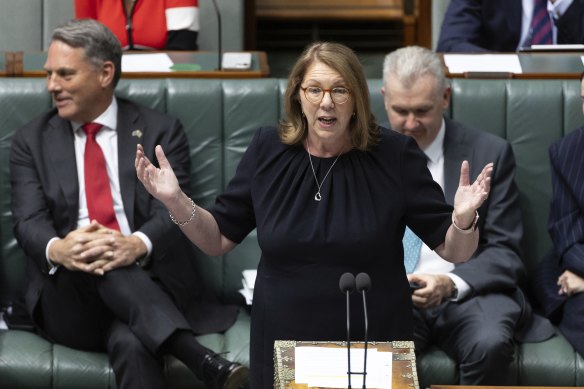
The airport will also need to develop and implement a strategy to make noise more tolerable in the worst-affected communities, such as paying for thicker windows and extra insulation to help reduce noise pollution.
King said she had kept community needs in mind while considering the project.

Federal Transport Minister Catherine King.Credit: Alex Ellinghausen
“These represent the most comprehensive set of conditions for a project of this type,” she said.
“My decision to require that the airport maintain sufficient capacity on the existing east-west runway is to support effective noise sharing … so that no one community bears the brunt of the airport’s growth.
“The noise sharing plan will be developed by the airport, and in consultation with local communities, over the years to come.”
King said a third runway will bring Melbourne Airport in line with Sydney and other globally competitive airports.
“This is a long-term project – the runway won’t be open for some time.
“But these conditions, along with relevant environmental requirements, mean that we are balancing the growth of the airport with the needs of the communities on the ground.
Airport chief executive Lorie Argus has previously said that the demise of two local airlines this year, Bonza and Regional Express, proved the need for a third runway, because both operators complained about difficulty securing take-off and landing slots at Sydney Airport.
Loading
On Thursday, Argus welcomed the approval and said it would add $6 billion a year to the state’s economy.
“The new north-south runway will ensure Victoria’s primary international gateway has adequate capacity to serve the state’s needs for future generations,” she said.
“Sydney and Brisbane already operate parallel runway systems, so this will ensure that Melbourne does not become a handbrake on the national air network or the national economy.
“The new runway will require new flight paths, and as part of this project we will be facilitating noise attenuation for dwellings in the most-impacted areas.”
Tullamarine was surrounded by green fields when Melbourne Airport opened in 1970. Concerns about aircraft noise emerged as the city’s population boomed and the suburban fringe expanded north and west.
In August, the Australian Financial Review reported on community concerns that Labor’s popularity could be damaged by the new flight paths in the party’s heartland ahead of the election, particularly in seats targeted by the Greens.
The Morning Edition newsletter is our guide to the day’s most important and interesting stories, analysis and insights. Sign up here.



























